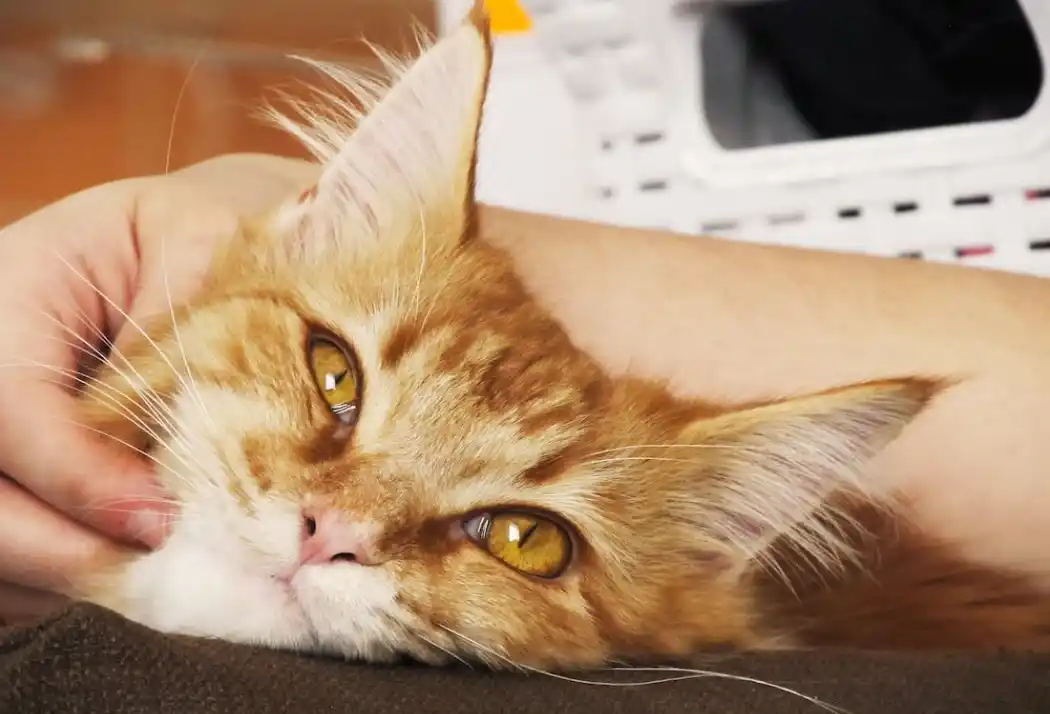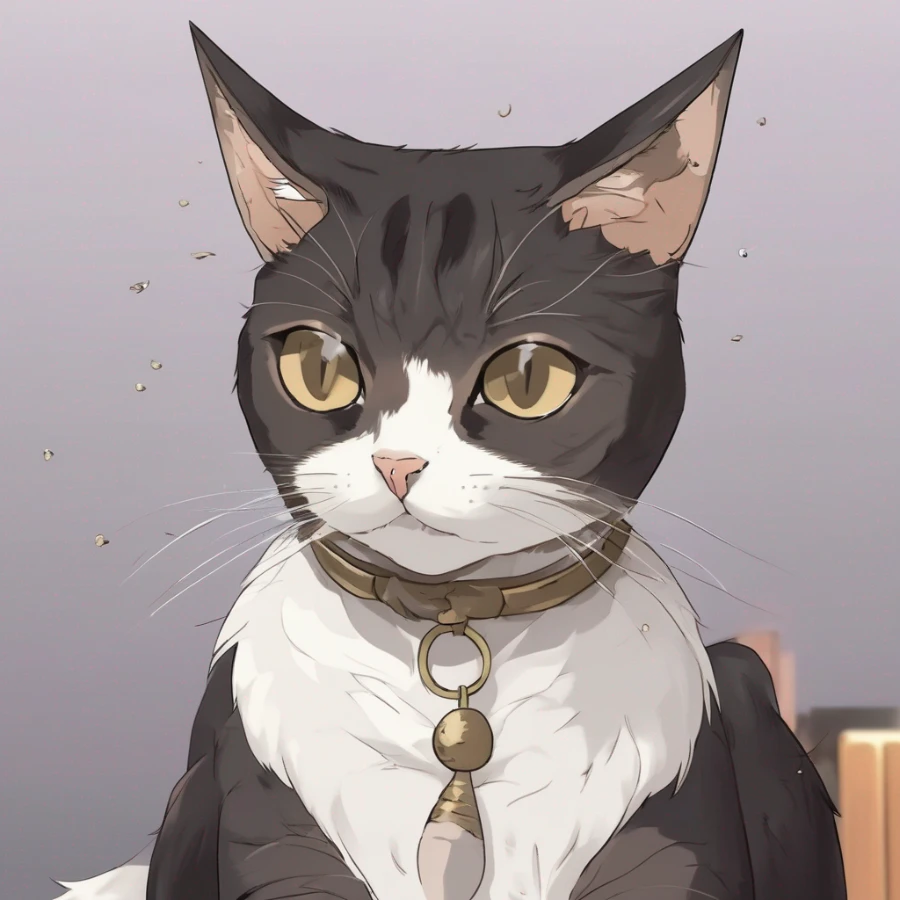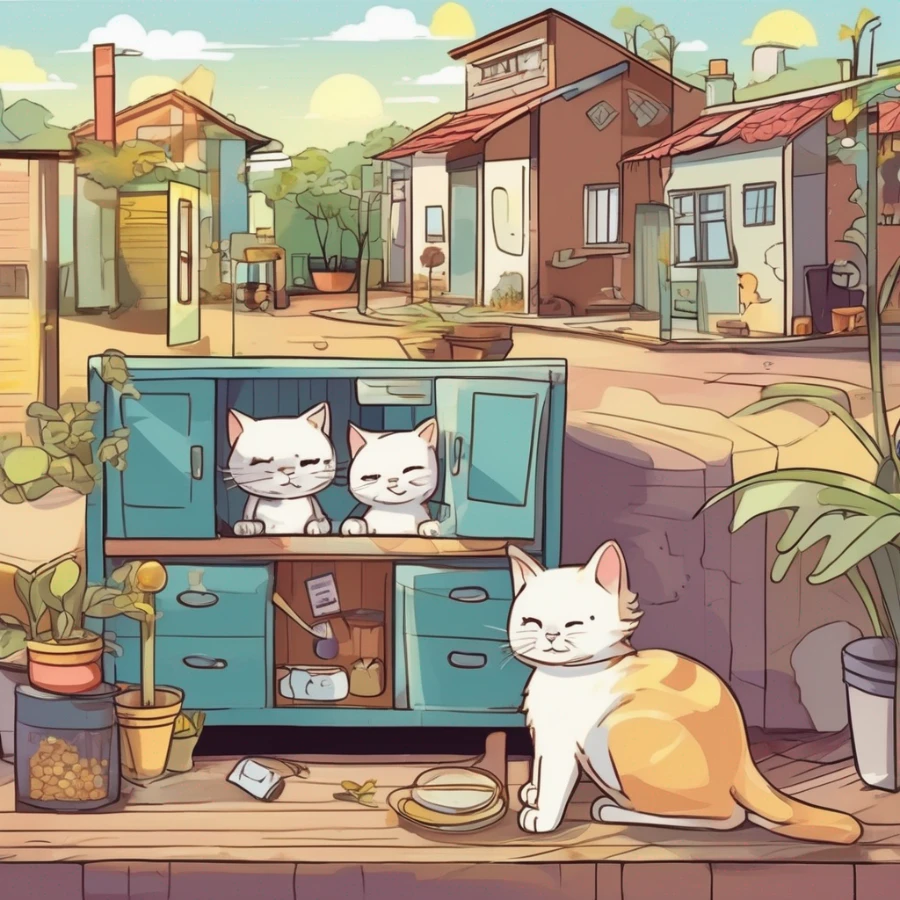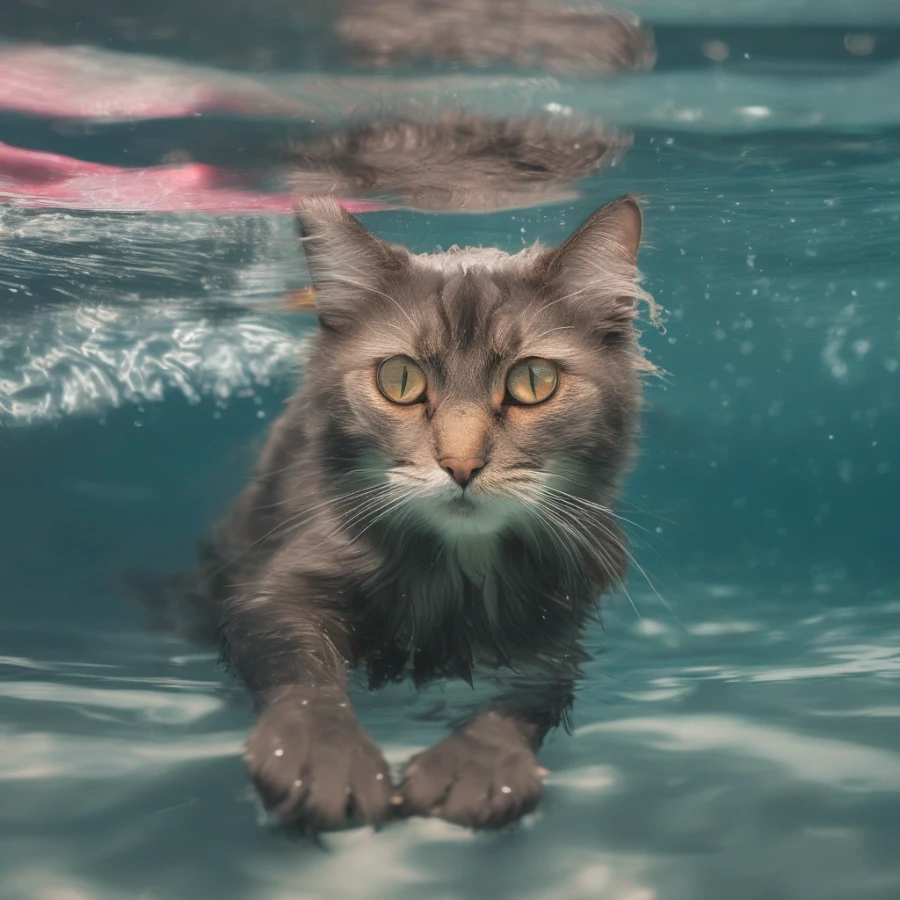How to keep your cat cool in summer

Published by: Tatsiana Korshik
Time to Read: 6 Min

As the temperatures soar during a heatwave, it's not just humans who struggle with the scorching weather – our feline friends are also susceptible to the heat. Cats can't sweat like we do, making it challenging for them to regulate their body temperature in extremely hot conditions. As responsible pet owners, it's crucial to take extra measures to keep our beloved cats cool and comfortable during the summer heat. Here are some top tips to ensure your furry companions stay safe:
Hydration is Key: Make sure your cat has access to fresh and cool water at all times. Cats can easily become dehydrated in hot weather, so providing multiple water bowls around the house is essential. You can also consider adding ice cubes to their water bowl to keep it cooler for longer.
Create Shady Retreats: Cats love basking in the sun, but during a heatwave, they need cool, shaded areas to retreat to. Set up umbrellas or create DIY shelters in your backyard or on your balcony, ensuring that your cat has plenty of shady spots to rest.
Utilize Fans or Air Conditioning: If possible, keep the indoor environment cool with fans or air conditioning. Cats will appreciate having a cooler place to relax and escape the heat. If you don't have air conditioning, consider using fans strategically to circulate air and create a more comfortable space.
Paw-Friendly Pavement: Avoid walking your cat on hot pavement, concrete, or asphalt, as it can burn their sensitive paw pads. If you need to take them outside, place a cool mat or towel for them to sit on.
Grooming for Comfort: Regular grooming can help your cat shed excess fur, which can improve their comfort during hot weather. However, avoid shaving their coat entirely, as their fur also acts as insulation and protects their skin from the sun.
Frozen Treats: Cats enjoy treats just as much as we do! Consider freezing small amounts of wet cat food or treats in ice cube trays for a cool and enjoyable snack.
Damp Towels or Cooling Pads: Place damp towels or cooling pads in your cat's favorite resting spots. The evaporating water can help to lower the surrounding temperature and provide some much-needed relief.
Limit Outdoor Activities: Try to keep your cat indoors during the hottest parts of the day. If they are outdoor cats, ensure they have access to shade and water outside. Cats are most active during the early morning and late evening, so schedule playtime accordingly.
Never Leave Pets in Cars: This is a crucial point for all pet owners. Never leave your cat unattended in a parked car during hot weather. Even with the windows cracked, the temperature inside a car can rise to dangerous levels quickly, posing a severe threat to your furry companion.
Watch for Signs of Heatstroke: Be vigilant for signs of heatstroke in cats, such as excessive panting, drooling, lethargy, vomiting, or difficulty breathing. If you suspect heatstroke, contact your veterinarian immediately – it's a medical emergency.
By following these top tips, you can ensure the safety and well-being of your furry friend during a heatwave. Remember, cats can't communicate their discomfort as effectively as humans can, so it's crucial to be proactive in keeping them cool and comfortable during hot summer weather. With a little extra care and attention, you can help your cat beat the heat and enjoy the summer months to the fullest. Stay safe and keep your pets cool!
Excessive Panting: Unlike dogs, cats don't normally pant unless they are extremely stressed or overheated. If you notice your cat panting heavily, it could be a sign of heat stress.
Restlessness: If your cat seems unusually restless and can't seem to find a comfortable spot, it may be trying to escape the heat.
Lethargy: Overheated cats may become lethargic and lack energy. They might spend more time lying down and seem less interested in their usual activities.
Elevated Body Temperature: Feel your cat's ears, paw pads, and body. If they feel excessively warm to the touch, it could indicate that their body temperature is elevated.
Excessive Grooming: Cats may groom themselves more frequently when they are uncomfortable. Excessive grooming can be a sign of stress and discomfort due to heat.
Seeking Cool Surfaces: Cats will naturally seek out cooler areas when they are hot. If you notice your cat lying on tile floors, near air vents, or in the shade, it could be a response to the heat.
Loss of Appetite: Heat can reduce a cat's appetite. If your cat isn't interested in food or water, it could be due to the heat.
Rapid Breathing: An increased respiratory rate could indicate that your cat is trying to cool down. If their breathing is unusually fast, it may be a sign of heat-related stress.
Vomiting or Diarrhea: Heatstroke can cause gastrointestinal issues, leading to vomiting or diarrhea in some cases.
Weakness or Collapse: In severe cases of heatstroke, a cat may experience weakness, stumbling, or collapse. This is a medical emergency, and immediate veterinary attention is necessary.
If you notice any of these signs in your cat during hot weather, it's essential to take immediate action to cool them down and provide a comfortable environment. Move your cat to a cooler area, offer fresh water, and dampen their fur with cool (not cold) water if they will tolerate it. Seek veterinary attention if your cat's condition does not improve or if you suspect heatstroke. Remember, prevention is key, so always be proactive in keeping your cat cool and comfortable during hot summer days.
Cats Can't Cool Themselves Like Humans: Unlike humans who can sweat to regulate their body temperature, cats have limited sweat glands, mainly found in their paw pads. They primarily rely on panting and seeking cooler environments to cool down. Without adequate measures to stay cool, they can quickly suffer from heat stress and even heatstroke.
Heat Stress and Heatstroke are Life-Threatening: When cats are exposed to extreme heat and cannot cool down, they are at risk of developing heat stress and heatstroke. These conditions can be life-threatening and require immediate medical attention. Prevention is the best approach to avoid these dangerous situations.
Cats are More Sensitive to Heat: Cats have a higher body temperature than humans (around 101.5°F to 102.5°F or 38.6°C to 39.2°C). As such, they can become uncomfortable and distressed in temperatures that might not seem excessively hot to us. It's crucial to be mindful of their sensitivity to ensure their comfort and well-being.
Dehydration and Health Complications: High temperatures can lead to dehydration in cats. Dehydration can then trigger various health complications, including urinary tract issues, kidney problems, and other illnesses. Providing ample fresh water is essential to keep them hydrated.
Paw Pad Burns: Walking on hot pavement, concrete, or asphalt can lead to burns on a cat's sensitive paw pads. It's crucial to protect them from hot surfaces and offer cooler alternatives to walk on.
Overheating Impacts Behavior: Cats feeling uncomfortably hot may exhibit changes in behavior, such as restlessness, irritability, and decreased appetite. Keeping them cool can help maintain their usual behavior and prevent unnecessary stress.
Preventing Heatstroke is Easier Than Treating It: Heatstroke can escalate rapidly and become life-threatening. By taking preventive measures and keeping our cats cool, we can avoid putting them at risk of this severe condition.
Cats Rely on Us for Safety: As domesticated animals, cats depend on their human caregivers to provide a safe and comfortable environment. Ensuring they have access to cool spots, shade, and fresh water is part of fulfilling this responsibility.
Reduce the Risk of Heat-Related Emergencies: Taking proactive steps to keep our cats cool can significantly reduce the chances of heat-related emergencies. A cool and comfortable environment contributes to their overall well-being and happiness.
Strengthening the Human-Animal Bond: By caring for our cats and safeguarding their health, we strengthen the bond between us and our beloved pets. Keeping them cool during the summer months is an expression of our love and commitment to their welfare.
In conclusion, keeping our cats cool during the summer months is not just about their comfort; it's a vital aspect of responsible pet ownership. Understanding their vulnerability to heat and taking proactive measures to keep them cool and safe can prevent serious health issues and ensure a happier and healthier life for our feline companions.
Move to a Cool Area: Immediately take your cat to a cooler environment. Find a shady spot, or preferably, bring them indoors to an air-conditioned or well-ventilated room.
Offer Fresh Water: Provide your cat with a bowl of fresh, cool water. Encourage them to drink, but don't force them. Hydration is crucial in helping them regulate their body temperature.
Dampen Their Fur: Use a damp cloth or towel to gently wipe your cat's fur with cool (not cold) water. Focus on the areas where their fur is thinnest, such as the paws, belly, and ears. Avoid using ice-cold water as it can shock their system.
Use a Fan or Air Conditioning: If available, turn on a fan or air conditioning to further cool down the room. Ensure there is adequate airflow to help dissipate the heat around your cat.
Avoid Submerging in Water: While it may be tempting to submerge your cat in water to cool them down quickly, most cats dislike being wet and may become more stressed. Dampening their fur with a cloth is often sufficient.
Offer Ice Cubes or Cold Treats: Some cats may enjoy licking or playing with ice cubes. You can also offer small, cat-safe frozen treats to help lower their body temperature.
Monitor Their Behavior: Observe your cat closely for any signs of improvement or worsening. Look for signs of distress, such as excessive panting, restlessness, or weakness.
Contact Your Veterinarian: If your cat's condition does not improve or if you suspect heatstroke, it's crucial to contact your veterinarian immediately. Heatstroke is a medical emergency that requires professional attention.
Be Cautious During Transport: If you need to take your cat to the veterinarian, avoid putting them in direct sunlight or a hot car. Use a well-ventilated carrier and cover it with a light cloth to shield them from the sun.
Prevent Future Overheating: After the incident, take steps to prevent your cat from becoming overheated again. Ensure they have access to cool areas, plenty of fresh water, and keep them indoors during the hottest parts of the day.
Remember, preventing overheating is always better than dealing with it after it happens. During hot weather, be proactive in keeping your cat cool and comfortable to avoid any potential health risks. Your swift response and care can make a significant difference in helping your feline friend recover from overheating and maintain their well-being.
Hydration is Key: Make sure your cat has access to fresh and cool water at all times. Cats can easily become dehydrated in hot weather, so providing multiple water bowls around the house is essential. You can also consider adding ice cubes to their water bowl to keep it cooler for longer.
Create Shady Retreats: Cats love basking in the sun, but during a heatwave, they need cool, shaded areas to retreat to. Set up umbrellas or create DIY shelters in your backyard or on your balcony, ensuring that your cat has plenty of shady spots to rest.
Utilize Fans or Air Conditioning: If possible, keep the indoor environment cool with fans or air conditioning. Cats will appreciate having a cooler place to relax and escape the heat. If you don't have air conditioning, consider using fans strategically to circulate air and create a more comfortable space.
Paw-Friendly Pavement: Avoid walking your cat on hot pavement, concrete, or asphalt, as it can burn their sensitive paw pads. If you need to take them outside, place a cool mat or towel for them to sit on.
Grooming for Comfort: Regular grooming can help your cat shed excess fur, which can improve their comfort during hot weather. However, avoid shaving their coat entirely, as their fur also acts as insulation and protects their skin from the sun.
Frozen Treats: Cats enjoy treats just as much as we do! Consider freezing small amounts of wet cat food or treats in ice cube trays for a cool and enjoyable snack.
Damp Towels or Cooling Pads: Place damp towels or cooling pads in your cat's favorite resting spots. The evaporating water can help to lower the surrounding temperature and provide some much-needed relief.
Limit Outdoor Activities: Try to keep your cat indoors during the hottest parts of the day. If they are outdoor cats, ensure they have access to shade and water outside. Cats are most active during the early morning and late evening, so schedule playtime accordingly.
Never Leave Pets in Cars: This is a crucial point for all pet owners. Never leave your cat unattended in a parked car during hot weather. Even with the windows cracked, the temperature inside a car can rise to dangerous levels quickly, posing a severe threat to your furry companion.
Watch for Signs of Heatstroke: Be vigilant for signs of heatstroke in cats, such as excessive panting, drooling, lethargy, vomiting, or difficulty breathing. If you suspect heatstroke, contact your veterinarian immediately – it's a medical emergency.
By following these top tips, you can ensure the safety and well-being of your furry friend during a heatwave. Remember, cats can't communicate their discomfort as effectively as humans can, so it's crucial to be proactive in keeping them cool and comfortable during hot summer weather. With a little extra care and attention, you can help your cat beat the heat and enjoy the summer months to the fullest. Stay safe and keep your pets cool!
Signs Your Cat is Too Hot
Recognizing the signs that your cat is too hot is crucial in ensuring their well-being during hot weather. Cats are more sensitive to heat than humans, so it's essential to be vigilant for any signs of discomfort or overheating. Here are some common indicators that your cat may be too hot:Excessive Panting: Unlike dogs, cats don't normally pant unless they are extremely stressed or overheated. If you notice your cat panting heavily, it could be a sign of heat stress.
Restlessness: If your cat seems unusually restless and can't seem to find a comfortable spot, it may be trying to escape the heat.
Lethargy: Overheated cats may become lethargic and lack energy. They might spend more time lying down and seem less interested in their usual activities.
Elevated Body Temperature: Feel your cat's ears, paw pads, and body. If they feel excessively warm to the touch, it could indicate that their body temperature is elevated.
Excessive Grooming: Cats may groom themselves more frequently when they are uncomfortable. Excessive grooming can be a sign of stress and discomfort due to heat.
Seeking Cool Surfaces: Cats will naturally seek out cooler areas when they are hot. If you notice your cat lying on tile floors, near air vents, or in the shade, it could be a response to the heat.
Loss of Appetite: Heat can reduce a cat's appetite. If your cat isn't interested in food or water, it could be due to the heat.
Rapid Breathing: An increased respiratory rate could indicate that your cat is trying to cool down. If their breathing is unusually fast, it may be a sign of heat-related stress.
Vomiting or Diarrhea: Heatstroke can cause gastrointestinal issues, leading to vomiting or diarrhea in some cases.
Weakness or Collapse: In severe cases of heatstroke, a cat may experience weakness, stumbling, or collapse. This is a medical emergency, and immediate veterinary attention is necessary.
If you notice any of these signs in your cat during hot weather, it's essential to take immediate action to cool them down and provide a comfortable environment. Move your cat to a cooler area, offer fresh water, and dampen their fur with cool (not cold) water if they will tolerate it. Seek veterinary attention if your cat's condition does not improve or if you suspect heatstroke. Remember, prevention is key, so always be proactive in keeping your cat cool and comfortable during hot summer days.
The Importance of Keeping Cats Cool During the Summer Months
As the mercury rises during the summer months, it becomes essential to prioritize the well-being of our feline companions and keep them cool. Cats are more susceptible to heat-related issues than humans, making it crucial for us, as responsible pet owners, to take necessary precautions. Let's explore why it's so important to keep our cats cool during this hot season:Cats Can't Cool Themselves Like Humans: Unlike humans who can sweat to regulate their body temperature, cats have limited sweat glands, mainly found in their paw pads. They primarily rely on panting and seeking cooler environments to cool down. Without adequate measures to stay cool, they can quickly suffer from heat stress and even heatstroke.
Heat Stress and Heatstroke are Life-Threatening: When cats are exposed to extreme heat and cannot cool down, they are at risk of developing heat stress and heatstroke. These conditions can be life-threatening and require immediate medical attention. Prevention is the best approach to avoid these dangerous situations.
Cats are More Sensitive to Heat: Cats have a higher body temperature than humans (around 101.5°F to 102.5°F or 38.6°C to 39.2°C). As such, they can become uncomfortable and distressed in temperatures that might not seem excessively hot to us. It's crucial to be mindful of their sensitivity to ensure their comfort and well-being.
Dehydration and Health Complications: High temperatures can lead to dehydration in cats. Dehydration can then trigger various health complications, including urinary tract issues, kidney problems, and other illnesses. Providing ample fresh water is essential to keep them hydrated.
Paw Pad Burns: Walking on hot pavement, concrete, or asphalt can lead to burns on a cat's sensitive paw pads. It's crucial to protect them from hot surfaces and offer cooler alternatives to walk on.
Overheating Impacts Behavior: Cats feeling uncomfortably hot may exhibit changes in behavior, such as restlessness, irritability, and decreased appetite. Keeping them cool can help maintain their usual behavior and prevent unnecessary stress.
Preventing Heatstroke is Easier Than Treating It: Heatstroke can escalate rapidly and become life-threatening. By taking preventive measures and keeping our cats cool, we can avoid putting them at risk of this severe condition.
Cats Rely on Us for Safety: As domesticated animals, cats depend on their human caregivers to provide a safe and comfortable environment. Ensuring they have access to cool spots, shade, and fresh water is part of fulfilling this responsibility.
Reduce the Risk of Heat-Related Emergencies: Taking proactive steps to keep our cats cool can significantly reduce the chances of heat-related emergencies. A cool and comfortable environment contributes to their overall well-being and happiness.
Strengthening the Human-Animal Bond: By caring for our cats and safeguarding their health, we strengthen the bond between us and our beloved pets. Keeping them cool during the summer months is an expression of our love and commitment to their welfare.
In conclusion, keeping our cats cool during the summer months is not just about their comfort; it's a vital aspect of responsible pet ownership. Understanding their vulnerability to heat and taking proactive measures to keep them cool and safe can prevent serious health issues and ensure a happier and healthier life for our feline companions.
What to Do If Your Cat Becomes Overheated
Discovering that your cat is overheated can be alarming, but it's essential to act quickly and calmly to help them cool down and prevent any potential heat-related emergencies. Here are the steps to take if your cat becomes overheated:Move to a Cool Area: Immediately take your cat to a cooler environment. Find a shady spot, or preferably, bring them indoors to an air-conditioned or well-ventilated room.
Offer Fresh Water: Provide your cat with a bowl of fresh, cool water. Encourage them to drink, but don't force them. Hydration is crucial in helping them regulate their body temperature.
Dampen Their Fur: Use a damp cloth or towel to gently wipe your cat's fur with cool (not cold) water. Focus on the areas where their fur is thinnest, such as the paws, belly, and ears. Avoid using ice-cold water as it can shock their system.
Use a Fan or Air Conditioning: If available, turn on a fan or air conditioning to further cool down the room. Ensure there is adequate airflow to help dissipate the heat around your cat.
Avoid Submerging in Water: While it may be tempting to submerge your cat in water to cool them down quickly, most cats dislike being wet and may become more stressed. Dampening their fur with a cloth is often sufficient.
Offer Ice Cubes or Cold Treats: Some cats may enjoy licking or playing with ice cubes. You can also offer small, cat-safe frozen treats to help lower their body temperature.
Monitor Their Behavior: Observe your cat closely for any signs of improvement or worsening. Look for signs of distress, such as excessive panting, restlessness, or weakness.
Contact Your Veterinarian: If your cat's condition does not improve or if you suspect heatstroke, it's crucial to contact your veterinarian immediately. Heatstroke is a medical emergency that requires professional attention.
Be Cautious During Transport: If you need to take your cat to the veterinarian, avoid putting them in direct sunlight or a hot car. Use a well-ventilated carrier and cover it with a light cloth to shield them from the sun.
Prevent Future Overheating: After the incident, take steps to prevent your cat from becoming overheated again. Ensure they have access to cool areas, plenty of fresh water, and keep them indoors during the hottest parts of the day.
Remember, preventing overheating is always better than dealing with it after it happens. During hot weather, be proactive in keeping your cat cool and comfortable to avoid any potential health risks. Your swift response and care can make a significant difference in helping your feline friend recover from overheating and maintain their well-being.



